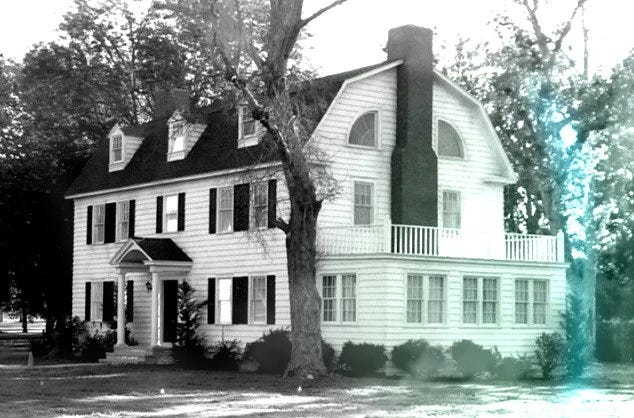You all know how much I love a multi-part series, but I wanted to experiment with a shorter format for some fun quick reads in between our larger scholastic pursuits.
Now, Halloween is almost upon us and nothing says spooky season quite like a good haunting. And what better place to start than one of the most infamous alleged hauntings in America: Amityville, NY?
But, are the horrors in this house real or are they of the manmade variety?
I guess you’ll just have to look at the evidence and make your own conclusions.
amityville, ny
It sounds silly to say, but most stories about haunted houses are, in essence, economic horror stories.
We joke a lot in these economic times about braving ghosts to be able to afford a home, but when you get to the meat of it, most stories about haunted homes revolve around people who are trapped there out of necessity. They either cannot afford to leave or have nowhere else to go, and the only way to survive is to abandon their investment and lose everything.
And there is no better example of this than what occurred at 112 Ocean Avenue in Amityville, New York in the winter of 1975.
112 Ocean Ave, Amityville, NY (circa 1976)
You might not be familiar with the address, but you’ve definitely heard of the town and likely the haunting that allegedly occurred in the sleepy coastal suburb that inspired multiple movies (and obviously at least one iteration that happens in space).
Who could forget Ryan Reynolds in one of his finest acting roles, portraying the possessed and often shirtless father, George Lutz, in The Amityville Horror (2005)?
Now, I’m sure most of you are at least somewhat familiar with the story:
On a cold night in November of 1974, 23-year-old Ronald “Butch” DeFeo Jr. murdered his mother, father, and four siblings at 112 Ocean Avenue. DeFeo later appeared at a local bar begging patrons for help, claiming he believed his parents had been shot.
The patrons rushed to the DeFeo residence to find the entire family had been slaughtered face down in their beds. When the police finally arrived, they were puzzled by the scene. DeFeo had used a rifle to kill his family, and yet no one in the house (or even the general vicinity) was awoken by the initial shots. They had all remained in their beds, asleep and unmoving while he carried out his massacre.
DeFeo could never provide an explanation for what happened that night. The only thing he could offer police was that once he began killing, he was unable to stop. Most people presumed that DeFeo’s history of heroin and LSD use, coupled with mental illness and his sudden interest in how to cash his father’s life insurance policy, was enough of an explanation for what happened that night, but others have wondered if it was something more—if there was something that made DeFeo go on a murderous rampage or if there was some force that muffled the sound of the rifle and prevented the murdered members of the DeFeo family from leaving their beds.
Then, barely a year after the DeFeo family was murdered, George and Kathy Lutz decided to purchase 112 Ocean Avenue at the deeply discounted price of $80,000.
And yes, the Lutzes were aware of the grisly massacre that happened not twelve months before, but the three-story coastal home was too tempting for the couple.
Kathy was a divorcee with three children from her previous marriage, and George was a former Marine who’d also been married once before. The pair had married in July of 1975, and rather than moving into one of the other’s existing homes, they decided to start fresh and buy a new place together.
And 112 Ocean Avenue felt like the perfect place to start over. It was in a wealthy neighborhood (that they could never have dreamt of affording) with better schooling for the kids. It came with an in-ground pool, a large boathouse, and canal access to the ocean.
Unfortunately, the deal was too good to be true.
A mere twenty-eight days after moving in, the Lutz family fled from 112 Ocean Avenue, taking only what they could carry and abandoning the home. They claimed that the house was haunted and that whatever lurked inside had tried to kill them.
The Lutzes claimed that strange events occurred from day one, even though they’d had the house blessed by a priest as they moved in. Locked doors would burst open, doors and cabinets would be slammed over and over then ripped from their hinges. Strange voices could be heard in certain rooms, green slime oozed from the walls, and some sort of demonic pig creature stalked the property at night.
Yes, you read that correctly, a demonic pig creature stalked the property at night.
George Lutz claimed that almost nightly a malevolent force would hold him down, while the house tormented different members of the family. He also stated that the same entity that caused DeFeo to kill his entire family, had begun to possess him, waking him up repeatedly at 3:15 AM (the time of the murders), and causing him to act out and hurt the children. George even alleged, on one occasion, Kathy was physically transformed into an old woman, before suddenly levitating in mid-air.
George also discovered a secret “red room” in the basement that contained proof of Satanic cult activity. He alleged one of the previous owners had been a Satanist, who’d purchased the home because it had been built on a Native American burial site.
You might be thinking this sounds like a lot—like something out of a movie, right?
Well, you wouldn’t be the first person to question the Lutzes’ rather fantastic story.
And it would be fair to wonder if the DeFeo murder house was actually haunted or if it was all an elaborate scheme by the Lutz family to escape a growing mountain of debt.
You see, while $80,000 might sound like a sweet deal for a massive coastal home in today’s housing market, it was actually about $30,000 over what the Lutzes could realistically afford. George and Kathy were initially looking for houses in the $30-50k range closer to the central part of Long Island but decided instead to overextend themselves on 112 Ocean Avenue and figure out how to make it work on the backend.
Unfortunately, they didn’t quite factor in all the costs of owning a large home from furnishing it to more basic things like paying utilities and property taxes.
Amityville had significantly higher property taxes, about three times what the Lutzes anticipated paying. And while having a massive coastal home was charming, it was not without downsides. Winters on the coast were brutal, and it was nearly impossible to heat a massive coastal home without breaking the bank.
The Lutzes also couldn’t afford to furnish the large home, so they took another deal that was probably not in the best taste and purchased all of the DeFeo family’s furniture, including the beds they were murdered in, for the low, low price of $400.
Why did they do it? Well, the Lutzes knew they could never afford to furnish the entire home, and that they would likely never be able to afford anything half as nice, so, at the time, it seemed worth scrubbing out a little blood.
They also decided to splurge on a speedboat they couldn’t afford, because what was the point of having a coastal home if you didn’t have a financial bottomless pit like a boat to upkeep?
So, clearly, the bills were starting to pile up, and to make matters worse, money wasn’t coming in quite steadily.
George Lutz, the family’s sole breadwinner, was a land surveyor by trade. Land surveyors determine the legal property lines and help determine the exact locations of real estate and construction projects, which is all well and good unless there are no new construction projects. Unfortunately, the United States was just starting to recover from a serious economic recession in 1975, and new construction projects were relatively limited in Long Island, which meant George wasn’t working very much.
George also had a few potential business debts on top of everything the family already owed, which didn’t help things.
On January 14, 1975, barely twenty-eight days after moving, the Lutz family decided they couldn’t take it anymore, grabbed whatever they could carry, and went to stay at Kathy’s childhood home in Deer Park until they could figure out what to do about the home. According to the Lutzes, whatever was in the house followed them to Deer Park, and the walls there began to ooze the same greenish slime.
We don’t know exactly what ultimately happened that sent them packing, as the Lutzes say their final hours in the house were too frightening to recount, but shortly after they left to stay with Kathy’s mother, the Lutz family decided to abandon 112 Ocean Avenue and go public with their story.
Five months after the Lutzes left Amityville, famed paranormal investigators and demonologists, Ed and Lorraine Warren, reached out to them. They wanted to conduct a formal investigation to see if there was any truth to the Lutzes story, and after spending one night in the home, they concluded that it was one of the most haunted locations they’d ever visited, reaffirming the Lutzes’ story.
There’s a lot that can be said about the Warrens, and we don’t have that kind of time today, but for whatever chicanery the Warrens got up to, they did seem to understand that many of the families they dealt with were dealing with horrors not just of the supernatural kind, but of the financial.
Sure, the Warrens were exploitative and did always manage to make their chunk of change, but they also gave these families something tangible they could make money off of (though whether or not that was a good idea is debatable).
And they did (mostly) help the Lutz family.
Because of the Warrens’ investigation, the story became national news, big enough that George was able to secure a book deal that would become such a big seller it would be optioned as a major motion picture only a few years later.
And while the Lutzes wouldn’t see more than $100-200K of the profit, mostly due to the series of lawsuits that followed the book and having to share profits with the actual author of the book, Jay Anson, they would have more than enough money to pay off their debts and leave the ghosts of their poor financial decisions behind.
Shortly after all the commotion, George and Kathy Lutz divorced in 1988. The two remained on good terms and stuck to their story until their passings in 2006 and 2004, respectively.
The eldest of the three Lutz children, Daniel, who was ten at the time they were living in the house, has repeatedly gone on record saying everything his step-father said was true and even appeared in a documentary about his experience in the house.
The middle child, Christopher, has also gone on record to say that while the book was an extremely exaggerated version of what happened, the family did experience a terrifying haunting.
The youngest of the three, Missy, has declined to publicly speak on anything related to her time in the home.
Sadly, we’ll probably never know if there was a real haunting in Amityville.
There have been no reports of any paranormal activity since the Lutz family departed from 112 Ocean Avenue. The movers who came to pick up their things (murder furniture included) said they did not experience anything strange, and no one who has lived there since has ever reported any paranormal activity.
Similarly, the couple that ultimately purchased the house from the Lutz family said they did not see any evidence of some of the more outlandish claims like doors that had been ripped off their hinges or a secret Satanic basement room. The only “red room” in the house was a basement closet that was not much of a secret.
We also know, from the multiple lawsuits against George and Kathy Lutz, that the property was not built on top of a Shinnecock tribal burial ground, and their personal lawyer admitted to cooking up most of the story with George and Kathy to get them out of debt.
However, there is one part of the Lutz family’s story that was not completely untrue. There was actually a priest who came to bless the house, and while he was not afflicted with disease by a demonic entity, he did later admit, on record, that while he was blessing the house, he did hear a voice firmly whisper “get out” and felt a hand shove him in the back.
Perhaps there truly are spirits at 112 Ocean Avenue or perhaps the story here is not the potential demons lurking within the home, but the lengths people are willing to go to own a home or to simply survive in a bad economy.
And that’s all she wrote…for now.
Resources:
The Amityville Curse: Fact or Fiction? by Hans Holzer
The Amityville Horror by Jay Hanson
The Amityville Horror Conspiracy by Stephen Kaplan and Roxanne Salch
Winter Book Club: The Amityville Horror by Sarah Marshall (You’re Wrong About Podcast)



